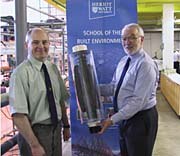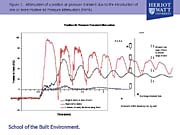This column has always advocated innovative solutions to design problems, whether likely to achieve instant standards approval or not. In order to move our profession forward, it is essential that we are open to persuasion and willing to accept solutions drawn from, or informed by, other engineering disciplines. The attenuation of positive air pressure transients is one such area.
The prevention of odor ingress from a drainage system carrying waste from sanitary appliances has been the major concern for system designers for over 100 years. While the water trap seal is accepted as the main protective device, these have to be protected to ensure that system design and usage will not generate air pressure transients of sufficient magnitude to lead to trap depletion.

Trap Seal Loss from Positive Air Pressure Transients
Trap seal loss may be caused by either negative or positive air pressure transients. Let's look at the protection of trap seals from depletion due to positive air pressure transients, the more complex and less well understood issue. Positive air pressure transients may be generated within a drainage network by a temporary closure of an entrained air path. The water discharge flows within drainage systems, particularly those in the system vertical stacks, entrain an airflow several times that of the water flow. In the vertical stack, this air moves within an annular water flow; however, the airflow path may be closed due to changes in stack orientation at the base of the stack or at any intermediate floor offsets.Traditionally, the design solution has been to provide an external vent to atmosphere. However, the source of positive air pressure transients is likely to be further down the system, as closure of the entrained air path requires sufficient water flow at the stack base or offset, implying a large number of upper floor contributing flows. Therefore, the provision of an external vent, while solving the problem of quasi-steady positive pressures, does not remove the positive air pressure transient threat to trap seal retention, as the transient once generated will propagate throughout the system, affecting all trap seals on its route to the high level open system termination.
Based on many years' experience with air pressure transient propagation within building drainage and vent systems, and earlier work on pressure surge and waterhammer, it was clear to me that the protection of trap seals requires a relief device between their likely source and an appliance. This follows the fundamental rule of surge protection-that the best way to relieve a positive pressure transient is to cut a hole in the pipe, or to provide an outward relief valve (see Julius Ballanco's solution to the exploding toilet event described in the Oct. 1998 PME). Clearly that would not be an acceptable solution in this application due to the need to prevent odor from escaping. However, opening the pipe or drain to a flexible and expandable bag within a containment vessel is a viable solution.

The Solution: A Positive Air Pressure Transient Attenuator
To address this design issue, David Campbell and I invented a positive air pressure transient attenuator that functions as an alternate path for the airflow interrupted by a water surcharge downstream. In addition, as the bag is made of fully flexible butyl rubber, the wave propagation velocity within the bag's air volume is substantially reduced. The optimum position for such an attenuator would be as a connection into a normally negative pressure zone within the system vertical stack so that the initial bag form would be fully emptied.Extensive laboratory optimization of the form and function of the air pressure attenuator was undertaken at Heriot Watt University (see experimental results in Figure 1). Simulations of multiple unit operation in multi-story buildings were undertaken using the Drainage Research Group's previously developed AIRNET model, and these were replicated in the laboratory.
Collaboration with Studor Ltd. has led to the production of usable units, an example of the role university research can play in finding innovative solutions to long standing drainage and vent system design issues. The use of the attenuator will alleviate trap seal loss by positive air pressure transient action. Such transients are necessarily of short duration. The attenuation is achieved by allowing an alternate path for the entrained airflow over a short period of time. The choice of bag material enhances the attenuation.
However, there are limitations. For maximum efficiency, the units should be installed in that portion of a stack normally under suction pressure. Similarly, as the device is designed to specifically deal with transient problems, its use will not address problems arising as a result of exposing the system to quasi-steady or continuous positive air pressures, as the bag would inflate to its full volume and cease to have an attenuating effect.
The device was intended to provide a modular solution to transient attenuation; series connections allow additional units to be added. While this increases the attenuating effect, the result is not linear; an additional unit mounted in series does not double the effectiveness. Similarly, the unit was designed to include the mounting of an AAV so that the combined unit could be used to provide both positive and negative transient protection to groups of fittings. However, with a collapsed bag, the airflow path to the drain is less efficient than via a direct AAV connection.
It will be interesting to follow the progress of this device through its consideration by both system designers and code authorities.